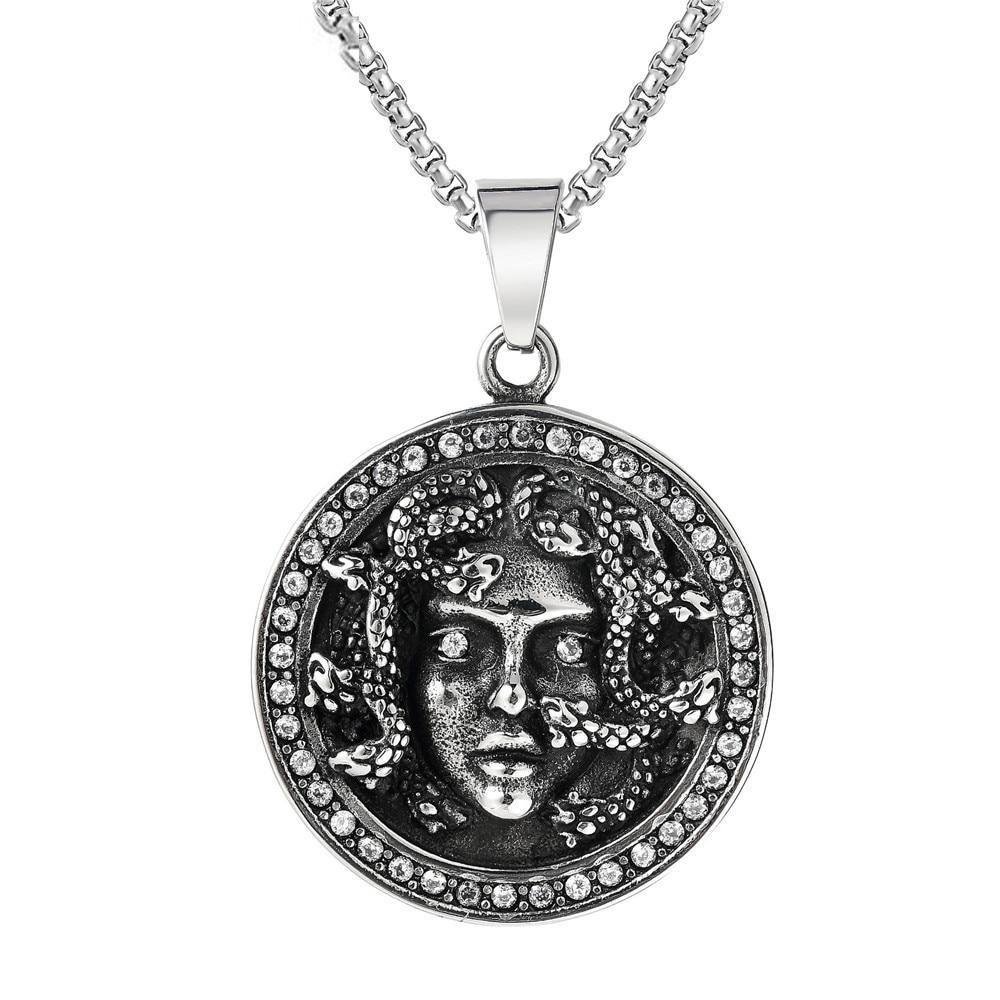The Gorgoneion (or Gorgon Head): Magical Amulet from Ancient Greece
Beauty is undoubtedly a dangerous thing… but so is ugliness!
In Greek culture, this idea was embodied through a particularly powerful lucky charm: the gorgoneion.
A sort of amulet representing the head of Medusa (a mythological creature), the gorgoneion is said to have the power to repel demons, evil spirits and other curses.
Between description, discovery of its powers and the legend which explains its creation: today we are going to learn the essentials about this ancient talisman.
Contents :

acquire power and knowledge
through ancient esoteric symbols
What is a gorgonion?
In ancient Greece, a gorgoneion was a magical amulet used as part of " apotropaic magic ". This term refers to a kind of magic where evil is repelled by something ugly, frightening or simply surprising. The ancient world was very fond of this type of magic. This could be seen through pendants in the shape of a phallus, gargoyles or even our famous Gorgon head.
A great symbol of protection against evil energies, the gorgoneion was linked to the god Zeus and the goddess Athena, two of the most powerful entities in the Greek pantheon. Here again, the powers of these deities can explain part of those of our amulet.
The real interest of this lucky charm, however, lies in its link with Medusa, a legendary monster which we will talk about in this article.
You will have understood: there is not just one reason that explains the great powers of this gorgoneion amulet or even this lucky signet ring that we both offer to our community.
In terms of its use, it seems that the gorgoneion appeared for the first time in Hellenic art during the 8th century BCE. Coins dating from this century were indeed found stamped with the head of Medusa. Some historians speak of an even older origin, around the 15th century BCE. They rely on depictions of similar creatures found on Crete to support their thesis.
Regardless, the fact is that the gorgoneion became a real phenomenon in ancient Greece. Coins, temple frescoes, street paving stones and shield decorations: at the height of civilization, we could find them absolutely everywhere.

And who are the Gorgons?
We have said it: the gorgoneion can also be called “ Gorgone head ” or “ Medusa head ”.
But actually, what is it about?
In reality, Medusa is one of the Gorgons, and the gorgoneion shows us her severed head.
It was the classical poet Hesiod who, in the 7th century BC, first wrote about the Gorgons. In his work, he presents us with three, three hideous sisters present in different tales but sharing the same ugliness:
- Stheno, the power
- Euryale, distant spring
- Medusa, the queen
Frightening on the outside as well as on the inside, these are three terrible monsters with female bodies but hair made of evil snakes. With their simple gaze, they can petrify any living being. They have long teeth that allow them to fly, sharp teeth and a taste for blood. To learn more about the Gorgons, you can refer to their Wikipedia page, which is rather complete and well sourced.
This shows that with the gorgoneion, apotropaic magic takes on its full meaning: even the most terrible of demons would not dare approach such a creature. The risk of being turned to stone, or simply devoured, is far too great.
In short, this explains why this symbol of death, fear and desolation serves as a shield to those who wear it.

The legend of the Gorgon's head
The story of Perseus and Medusa is of rare depth, and many historians consider it to be the founder of a part of Greek mythology. To learn more about it, this French national education resource should interest you. For our part, let's just understand Medusa's role in it.
When we talk about the Gorgon's head, we are really talking about the head of Medusa, the most powerful of the three Gorgons... and the only one who was defeated.
First of all, you should know that Medusa's fate is tragic. She was once a magnificent young woman full of life who, one day aiming for a temple of Athena, was visited by the god Poseidon. The lord of the seas had a clear idea: he wanted to give her a child. Medusa refused, but Poseidon gave her no choice. Forced and unable to fight a god, Medusa was raped.
When Athena learned of it, she was mad with rage: one of her temples had been defiled, desecrated. Unable to fight her brother in a direct war (this would have led to a destructive war between the gods of Olympus), she placed the blame on Medusa.
In addition to her initial pain, for which nothing made her responsible, she was transformed into a hideous monster, into the Gorgon that we know. Heroes and monster hunters from all over Greece then set out after her in the hope of killing the one who had become prey.
Victim during her lifetime and persecuted in death, Medusa's rage grew, and her power with it. Soon it became clear that she had become too powerful to fight. His anger had made him a being of rare strength and danger.
The hero Perseus, in his adventures, had to fight the queen of the Gorgons. The story is long and is not today's topic, but the fact is that he ends up defeating her and cutting off her head with a blow of his silver sword.
Perseus then offered the head of Medusa to Athena, who decided to hang it on her aegis (a Greek shield) so that its powers would protect her during her battles.
Since then, the Greeks have also used the head of Medusa through the gorgoneion to, as the goddess of war, protect themselves from their enemies.
Lucky charm featured in this article

Gorgoneion
See more
Signet with Gorgon's Head
See more
